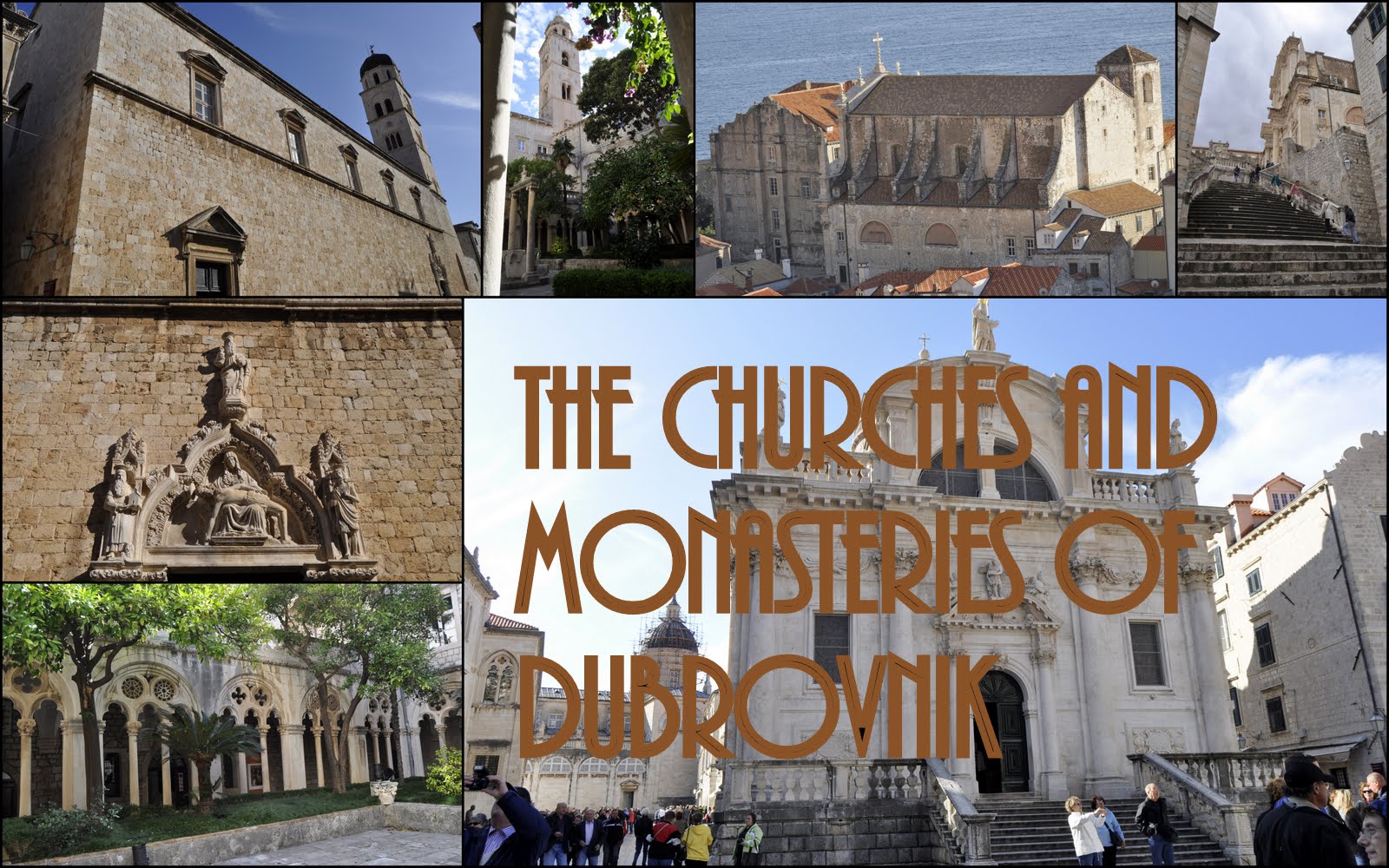
Note: This presentation provides further pictures and commentary for our Dubrovnik overview. It's best to see that presentation first by clicking here.
| You may prefer to see these pages as a photo slide show which contains the same text but presents the pictures full screen size. If so, click on the slides presentation at the right. |
Let's start with the Franciscan Monastery which anchors the west end of Dubrovnik, just inside the Pile gate and extends northward towards the Minceta tower.
Here we see the main drag, the Placa, teeming with chattel disgorged by cruise ships. Even in mid October, this can be a crowded town. We face west with the Franciscan Monastery anchoring the area just inside the Pile Gate.
Here we look west past the Franciscan monastery tower, over the Pile Gate, and towards Ft. Lawrence across the rocky but small west harbor.
This view shows the Pile Gate at mid-right; at center is the monastery. The tower is attached to the large church and the cloister unfolds towards us in this picture. At right the western walls showing a few of the square towers and the pleasant walkway for visitors.
The new monastery was built in 1317 inside the walls. The Franciscan monastery had one of the richest churches in Dubrovnik until the 1667 earthquake destroyed it (and most of the other buildings in town.) What was built after that was pretty simple as in this small ashlar wall. But at the far right we see...
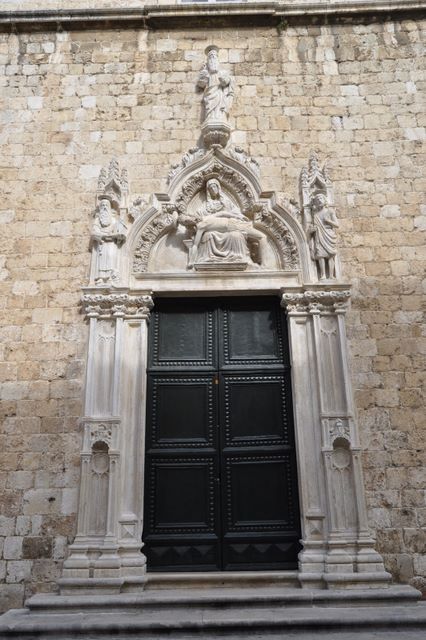
This lovely portal rescued from the pre-earthquake
building. When built in 1498, it was the most elaborate
in Dubrovnik. The Petrovic brothers (Leonard and Petar)
had the best workshop in town when they carved this.
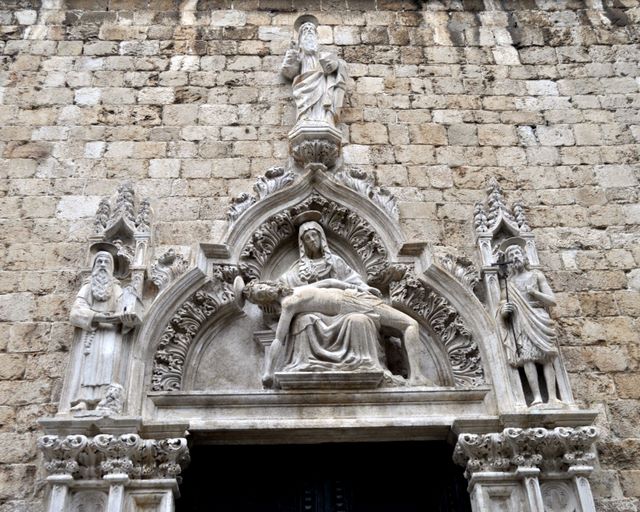
At top God the Father presides over the Pieta below. At
left we have St. Jerome with a model of a church (a
common Gothic presentation) and John the Baptist at
right. While Gothic (check those Frisbee halos!), the
fabric folds and facial expressions presage the
Renaissance. (Could Mary look more sour?) Check the
intricacy of the leaf work, perhaps done by one anonymous
member of the Petrovic workshop. (Medieval craftsmen
tended to specialize in certain objects and often left
the faces for the master to carve.)How much of this
building is found art? Were these humble ashlar stones
chiseled from those that fell when the trembling of the
earth destroyed the building that came before?
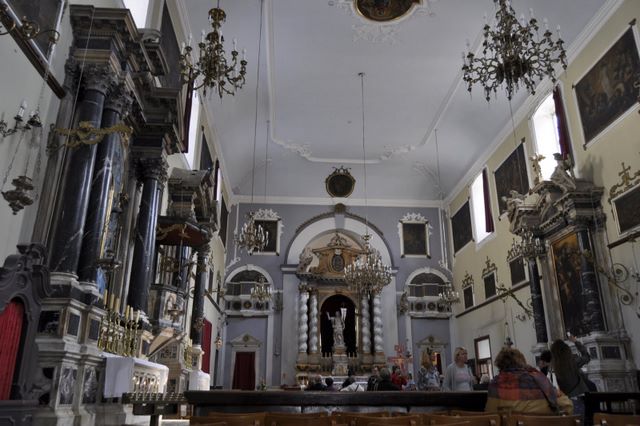
That magnificent entrance leads to this "hall church"
inside. Instead of the typical 3 naves, the mendicant
orders preferred these large rectangular spaces where
they could preach to large crowds from pulpits near the
center of the congregation (we see one here on the left
wall). We look here towards the front.
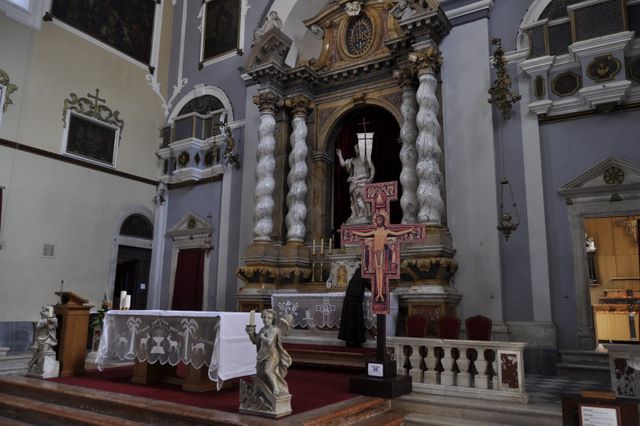
The main altar appears baroque, especially the twisted
(tortile) columns that suggest the Baldacchino placed by
Bernini in St. Peter's in Rome a few decades before the
earthquake struck here.
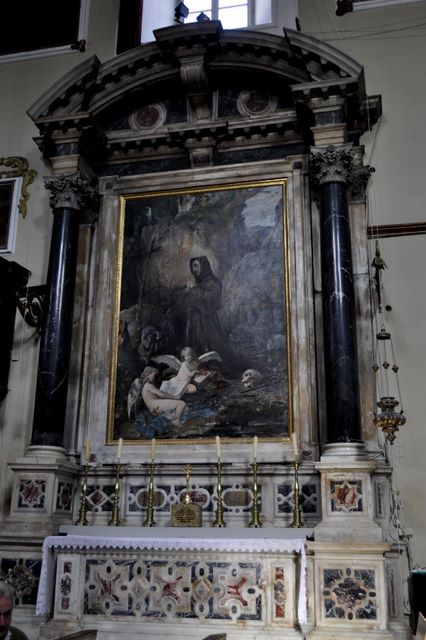
The inlaid marble of the side altars steals the focus
from the oil paintings of Franciscan saints.
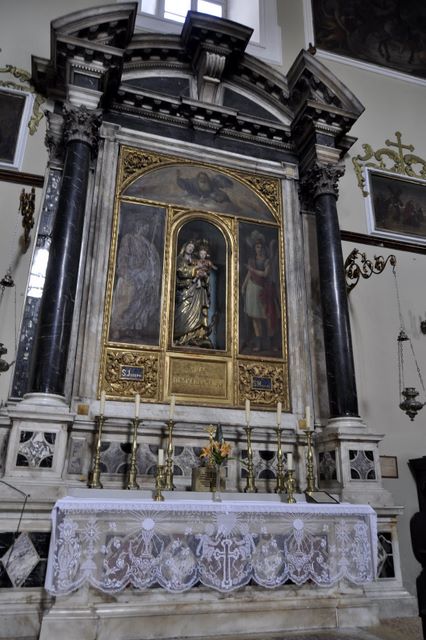
Here some elaborate lacework hides the inlaid marble
beneath this Marian altar.
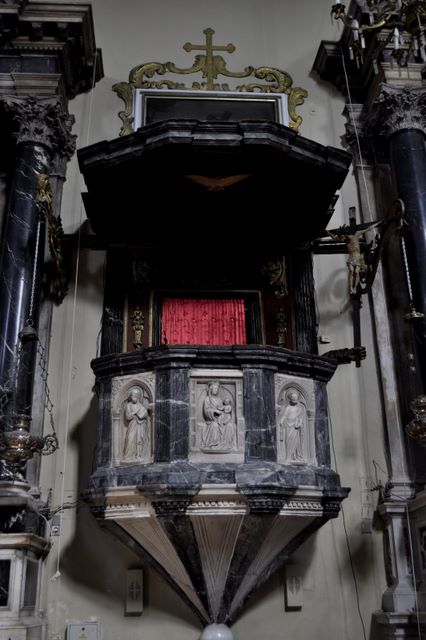
Somehow this 15th century marble pulpit escaped
destruction during the great earthquake of 1667.

While missing a few fingers, this is still a pretty good
guardian angel with remarkable wing feathers. It guards
the Franciscan side altar.
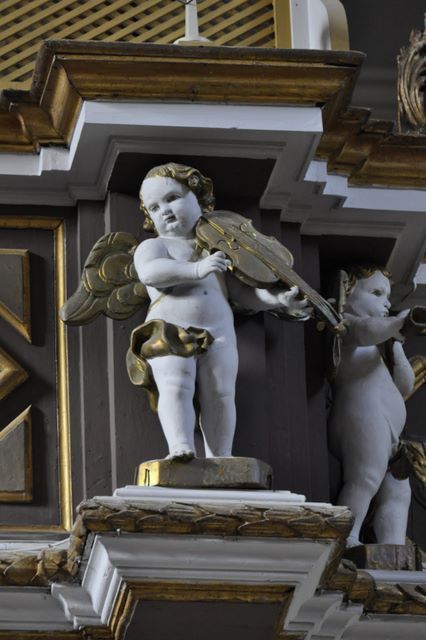
The artistry of other angels is not as high but the
thought is interesting...
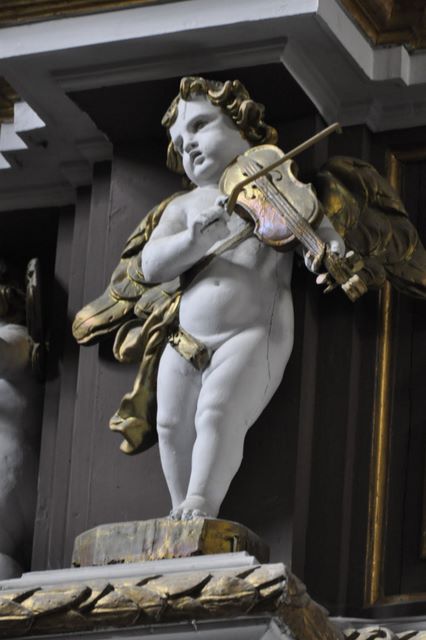
...and the gilded fig leaf is minimal but adequate in
those days of cherubic obesity. Should we put diet cokes
in heaven's vending machines?
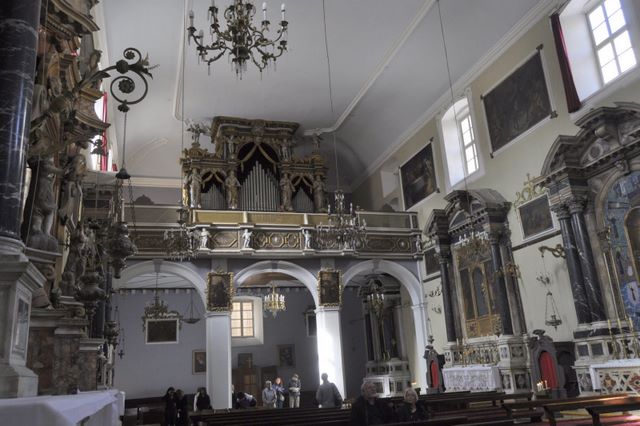
The ornate baroque organ and choir loft take up the
entire rear.

The organ sports religious telamans (telamen?) above the
cherubic musicians.
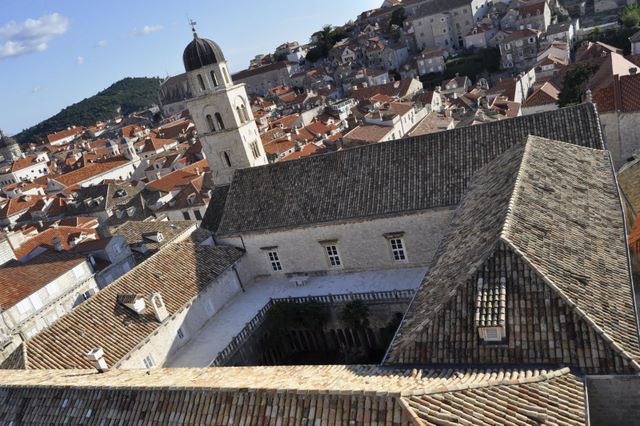
At rear is the church and at lower center is the
magnificent Romanesque cloister built in 1360 and which
survived undamaged from the 1667 earthquake.

The Franciscan Monastery's garden is the oldest existing
garden in Dubrovnik. It dates from the 14th and 15th
centuries. The layout is most unusual: most monasteries
have a fountain centered on two cross paths.
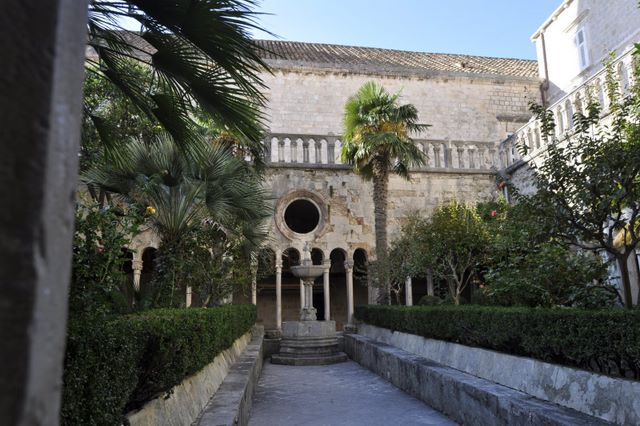
But instead of being centered on cross paths,
Dubrovnik's Franciscan monastery cloister fountain is at
the end of a wide path with stone niches on either side.
This fountain is the 1438 work of Dubrovnik's master
water carrier: Onofrio di Giordano della Cava.
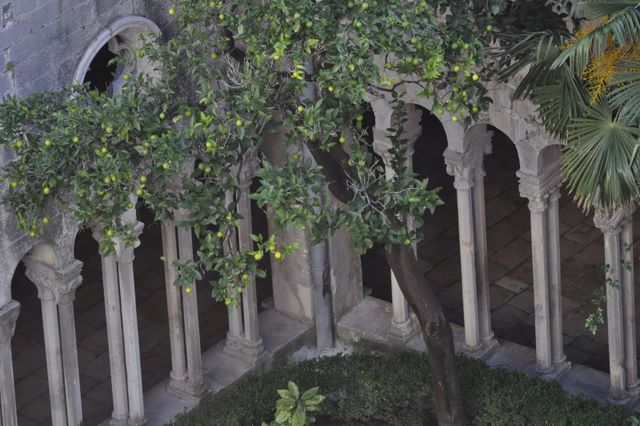
In addition, this garden featured plants from Italy and
Sicily. Gardening began to be accepted as a craft in the
13th century. (Thanks to Mladen Obad
Šćitaroci for much of the
information on this garden.)
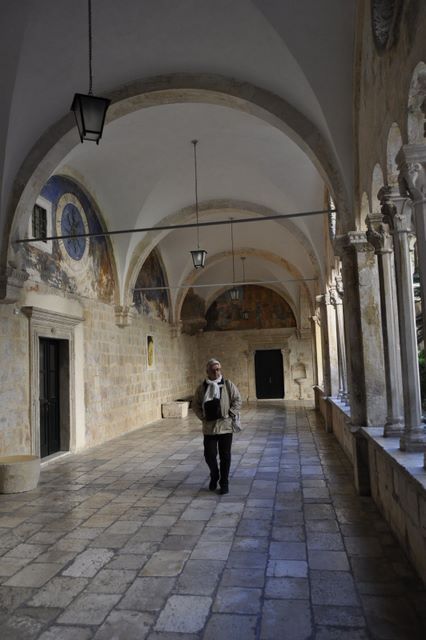
Most art work (for which Dubrovnik was well known) was
destroyed in the 1667 earthquake. Since this cloister
survived that catastrophe, we wonder if the paintings in
the lunettes may hold some of the pre earthquake
frescoes.
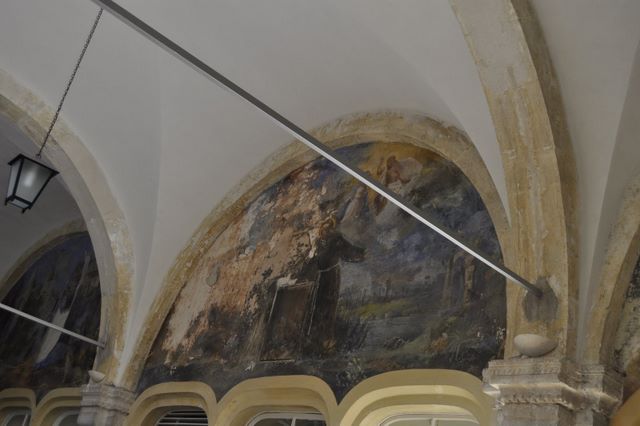
No matter. What's there is generally pretty
deteriorated.
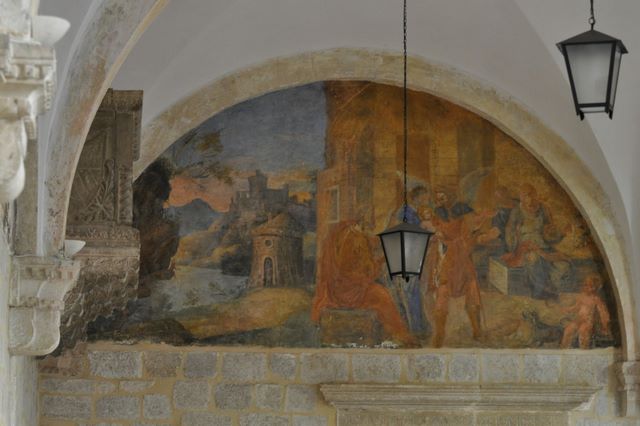
One of the best-preserved frescoes in the lunette near
the northeast corner of the cloister.
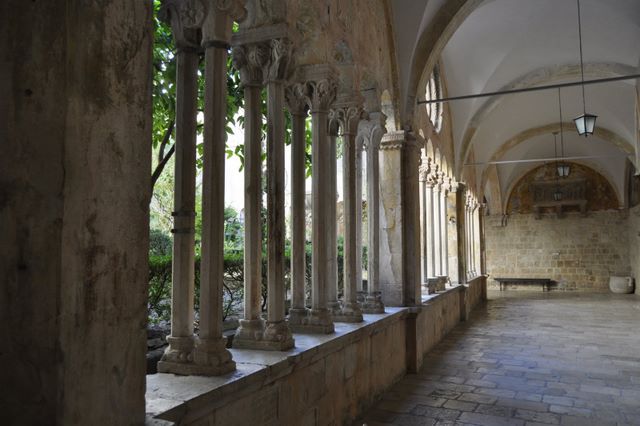
The north walkway leads to a hanging sarcophagus that we
will view in a minute.
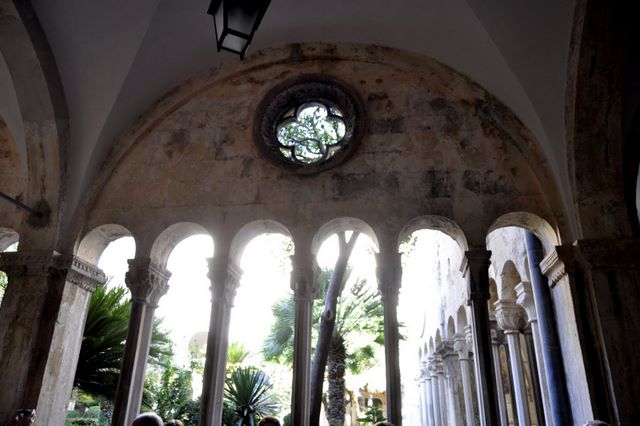
Arches are narrow, creating the opportunity for many
columns and highly individualized capitals to crown
them.
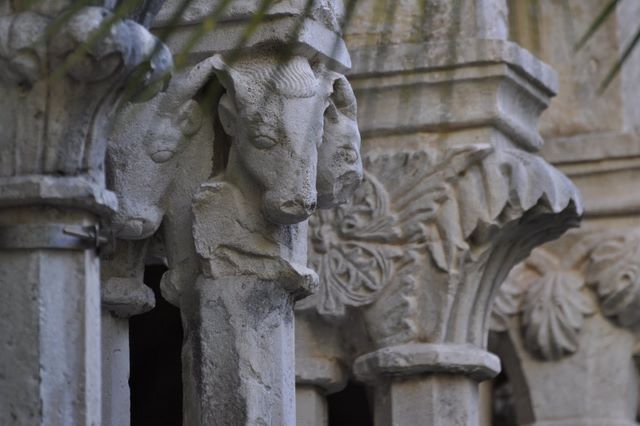
Let's look at a few of these capitals which often do not
appear to have the kinds of religious iconography one
might expect in a religious cloister.

A mammal head, bird wings, and serpentine tail.
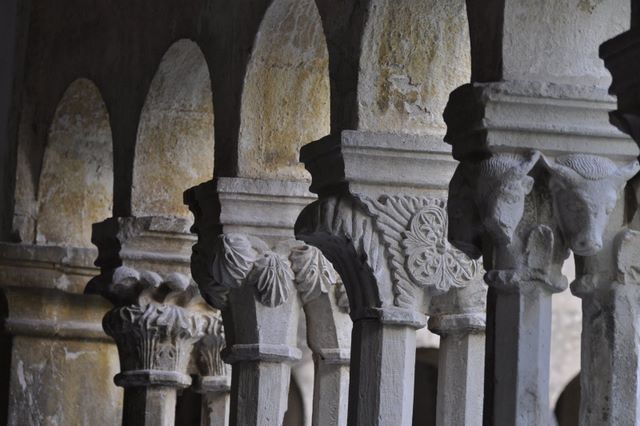
Here we have almost Arab-inspired carved vegetation.
Dubrovnik sailors knew Arab architecture well as they
sailed the length of the Mediterranean.
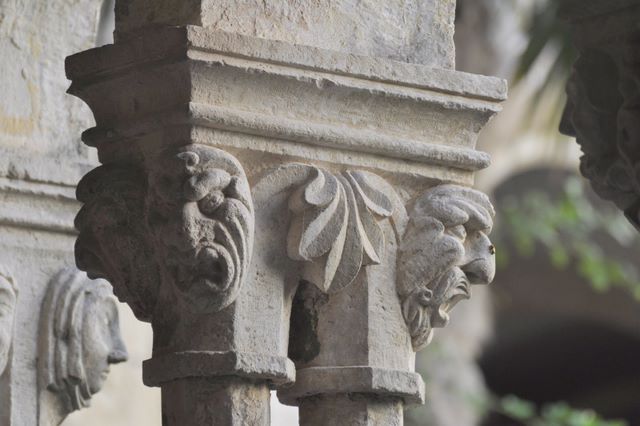
The Franciscan monastery also housed, for its day, a
world famous library including 137 incunables (which is
what we call early printed books from Gutenberg through
the end of the 15th century. (A bit of explanation for
our younger readers: books were what we used to
distribute misinformation before the internet so rudely
arrived.)
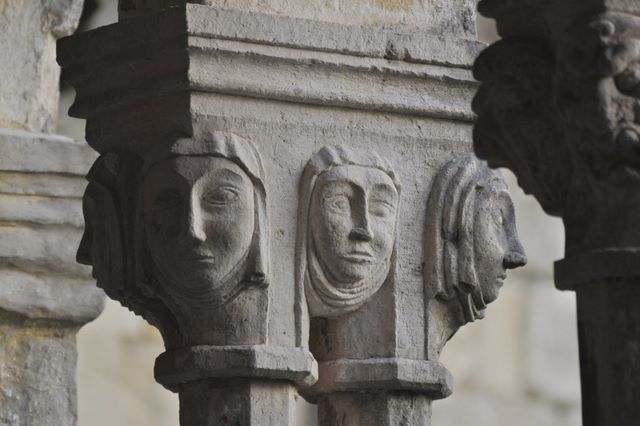
The monastery claims also to have one of the oldest
pharmacies (from 1317) still in use in Europe, although
it primarily sells lotions to tourists rather than
serious pharmaceuticals.
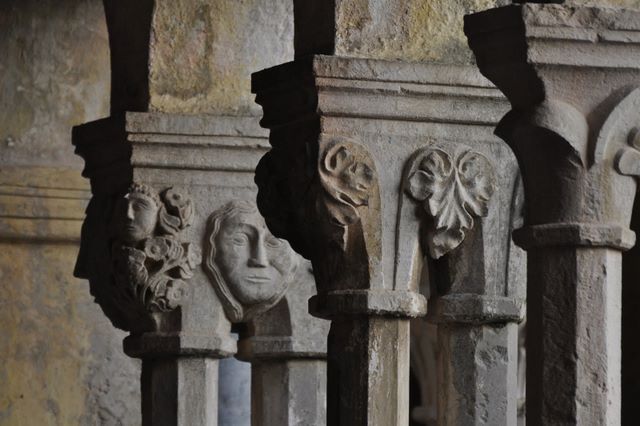
The pharmacy is in the chapter house across from a small
museum housing a number of religious artifacts and
relics.
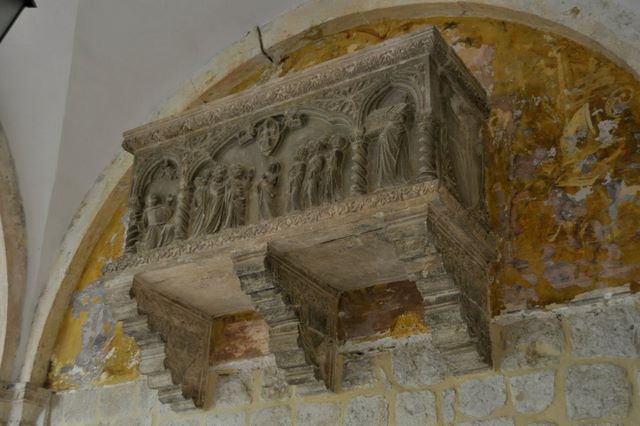
High above where the east wall meets the north walkway,
hangs this well-preserved sarcophagus...
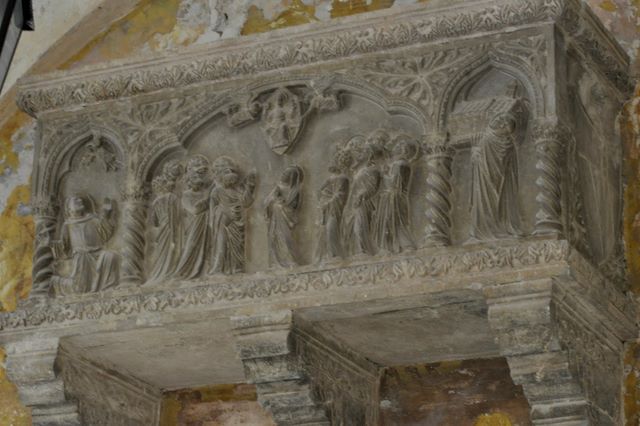
...which appears to center on the Ascension. On the left
may be St. Francis receiving the stigmata.
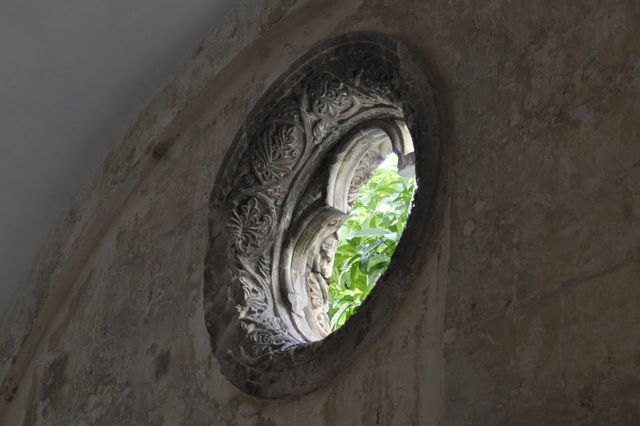
While the cloister is considered one of the most
significant Romanesque structures along the Dalmatian
Coast, this window seems quite Gothic.
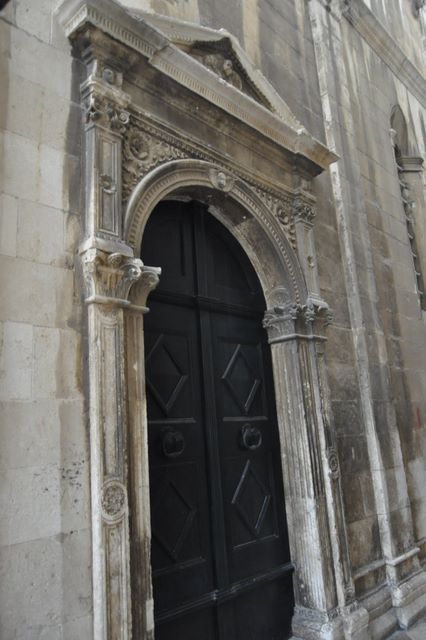
This door is just off the passageway that leads into the
cloister from the Placa, the main drag. The narrow path
makes it difficult to appreciate its elaborate
carving.

Between the Franciscan Monastery and the Pile Gate rises
perhaps the only church to survive Dubrovnik's
devastating 1667 earthquake -- The Church of the
Saviour.
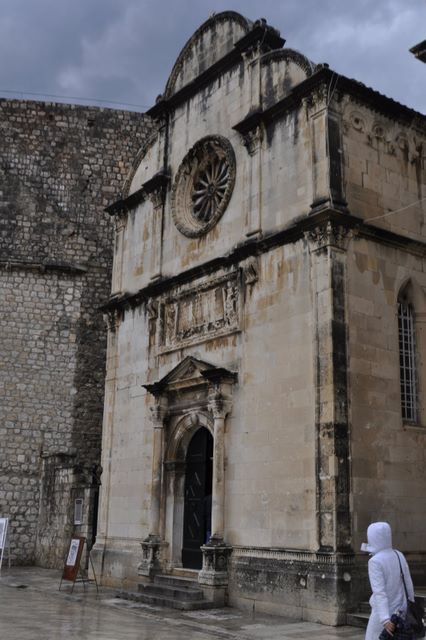
This Renaissance church was commissioned by the
Dubrovnik Senate and completed in 1528 in thanksgiving
for the city surviving the 1520 earthquake. Its 3-leaf
semi-circular cap bears a strong resemblance to that of a
church we would see at the end of our trip in
Venice...
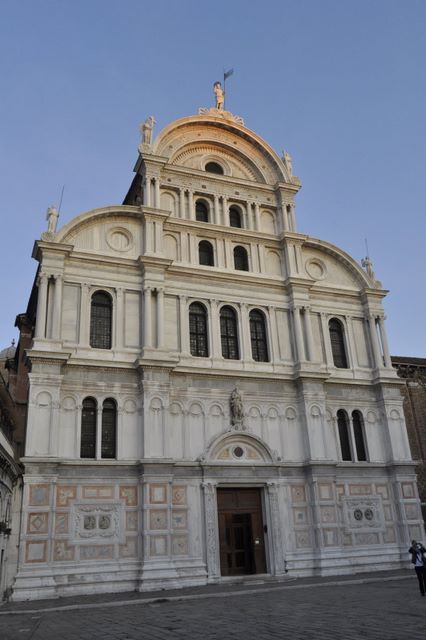
...the iconic St. Zaccaria near St. Mark's. St.
Zaccaria's acquired this facade a few decades before it
was copied here in Dubrovnik (and eventually in many
other places throughout the region.) It's the the design
of Mauro Codussi who did several of Venice's church
facades as well as St. Mark Square's clock tower. These
two facades built at roughly the same time suggest how
much more affluent Venice was than its rival maritime
republic Dubrovnik.
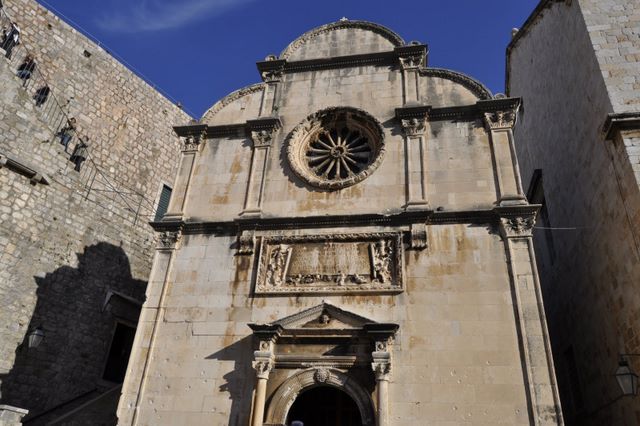
Architect Petar Andrijic of Korcula created this lower
budget version of St. Zaccaria's as Dubrovnik was rising
in power and entering its golden age. This church, in
turn, was imitated elsewhere in Croatia as we would see
when we arrived on the island of Hvar. At upper left,
tourists climb to the top of the city walls at the Pile
Gate.At the center between the rose window and the
doorway is...
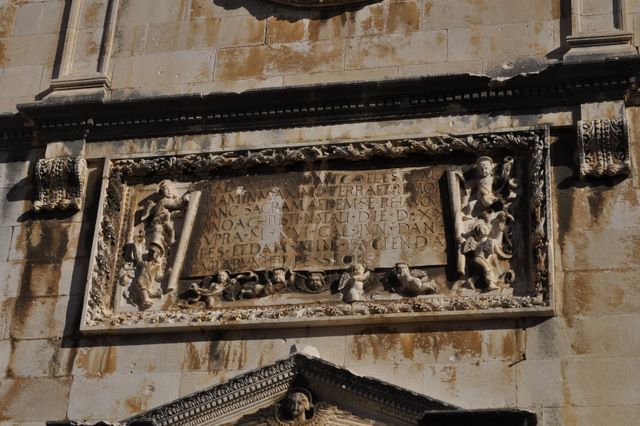
...this scroll informing the population of the survival
of the city.
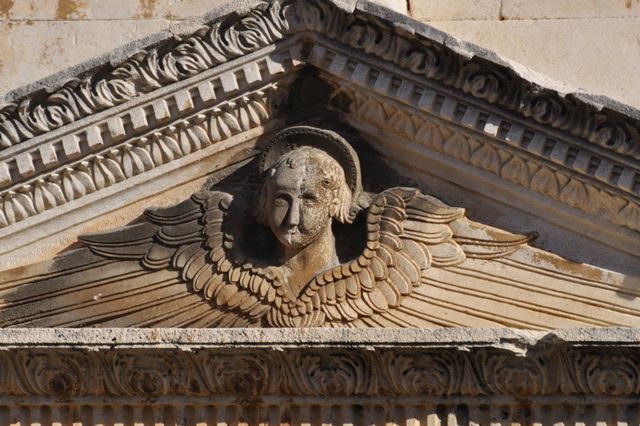
Below the scroll we find this angel in the tympanum. Her
mojo was good as the church survived the 1667
earthquake...
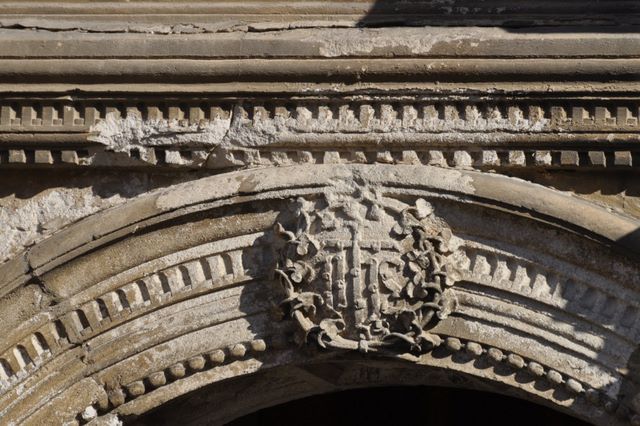
...but not quite good enough as the 1667 disaster
leveled nearly every building in the city and pretty well
ended Dubrovnik's golden age. Here we see the fading IHS
monogram in the carved arch above the door. You
Jesuitphiles, don't think it belongs to you, as the order
would not be founded until a generation after San Saviour
rose to the skies after the earth trembled the first
time.
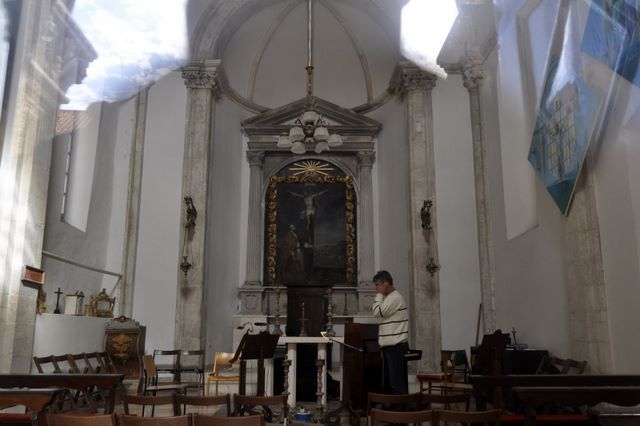
The church was locked but as my Nikon kissed the glass,
it captured this curious mixture of church and heaven --
perhaps Salvatore Dali meeting the Renaissance. From the
looks of the Vatican II altar, this is still used as a
church. Here, however, it is being prepared for a bit of
chamber music. The semi-circular apse meets Gothic
vaulting not visible in this picture.
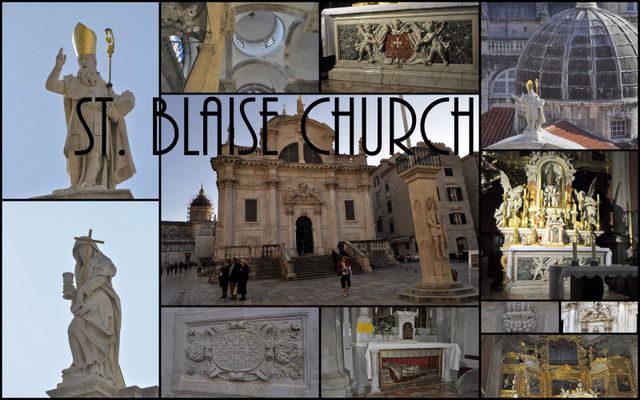
Those of you who survived Catholic grade schools
probably recall getting your throats blessed by those
criss-crossed candles on February 3 -- the feast of St.
Blaise, the patron of Dubrovnik.
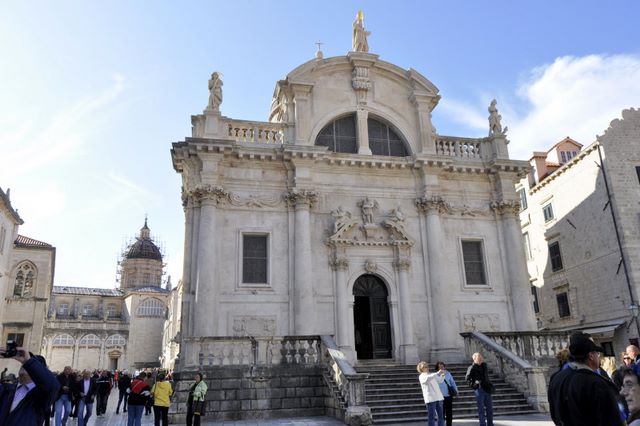
Built in 1715, St. Blaise church was a Baroque
replacement for the Romanesque church badly damaged by
the 1667 earthquake and then destroyed in a 1706 fire.
The Senate then hired Marino Gropelli to mimic the church
of St. Mauritius in his native Venice.
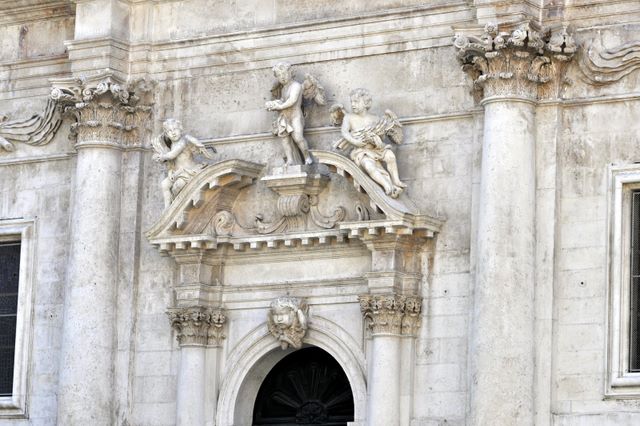
I'm not sure how many of the external sculptures are by
Gropelli, who may be best known for the Baroque statues
in St. Petersburg's Summer Garden. Let's look at a few
details around the central portal.
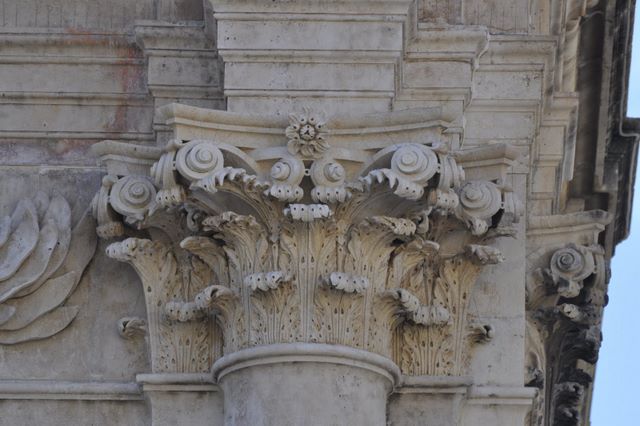
Above: The baroque explosion of the Corinthian
capital
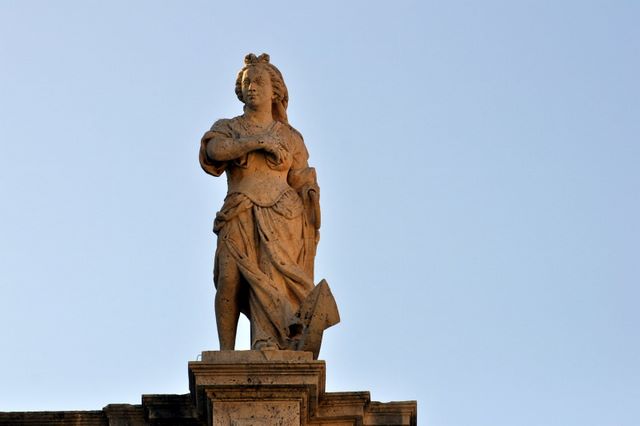
Three statues command the top of the church. At the west
corner we see this woman rising above an anchor...
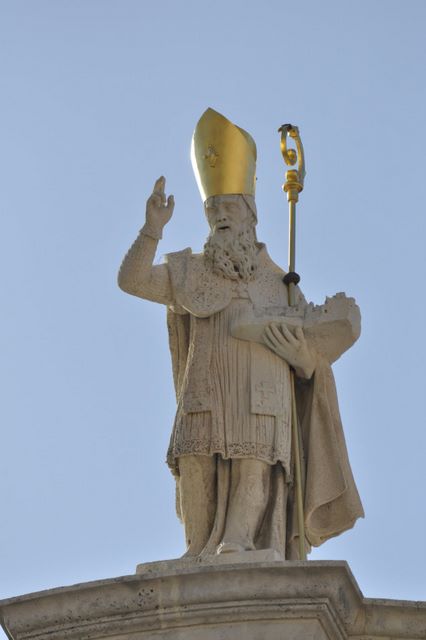
...with St. Blaise at center posing, as is often the
case in this town, with a model of his city...
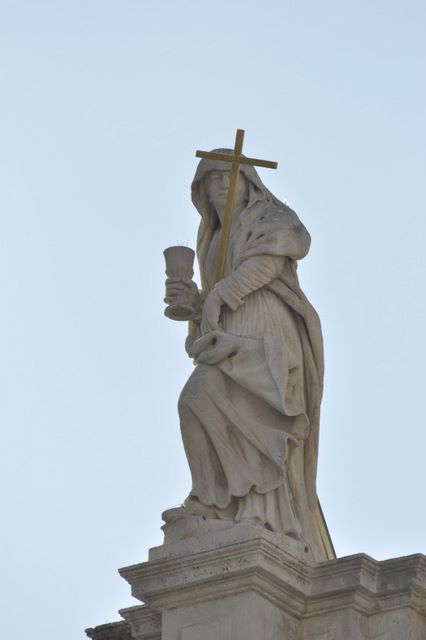
...and this religious figure at the east end with cross
and chalice.
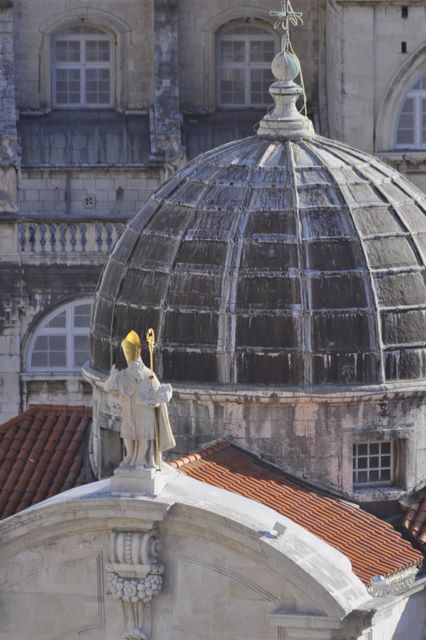
Behind St. Blaise rises the church's oblong dome...

...which we see very sparsely decorated for a baroque
interior.
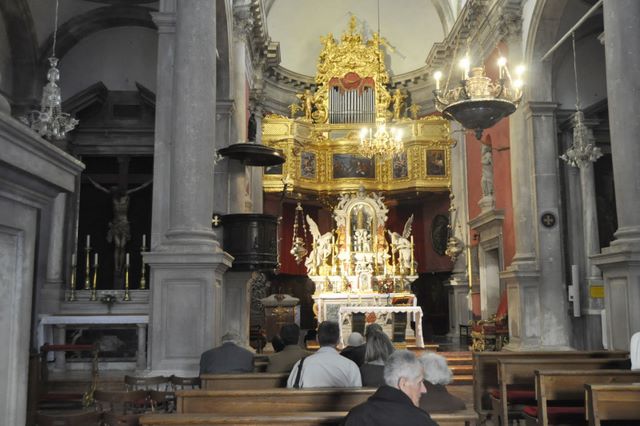
The main altar does show typical Baroque elements...

...including the marble altars. Note the small statue of
St. Blaise at top center, one of the few icons to survive
the fire -- and therefore considered miraculous. He holds
a city model considered to be an accurate depiction of
Dubrovnik before the earthquake.
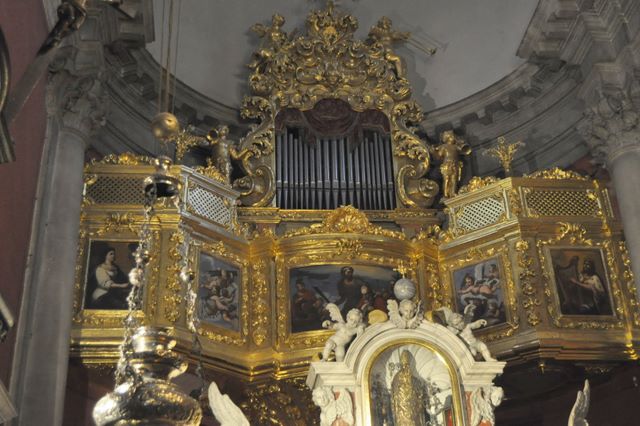
The organ pipes here are above the main altar and
include gold framed oil paintings.
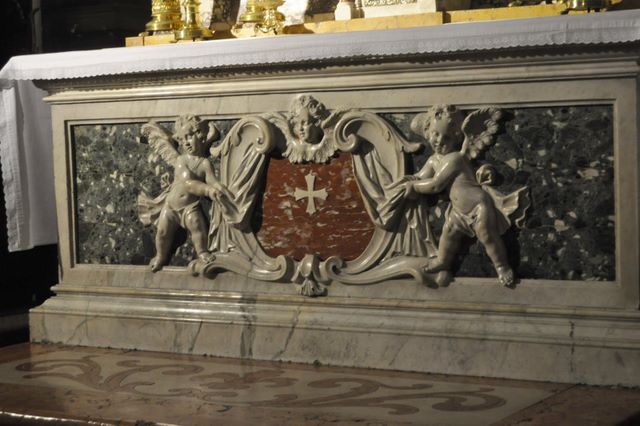
Quite the inlaid marble altar with delicate facial
features and drapery folds!
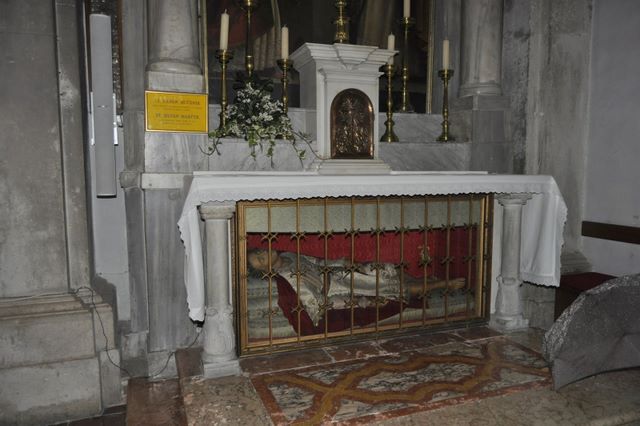
On the epistle side are the relics of St. Silvan Martyr
brought here from Rome in the 19th century. Supposedly
this is no effigy but the incorrupt body of the saint,
one of dozens so designated (but scientifically unproven)
by the Catholic Church. Maybe his eyebrow wax was
generously applied.
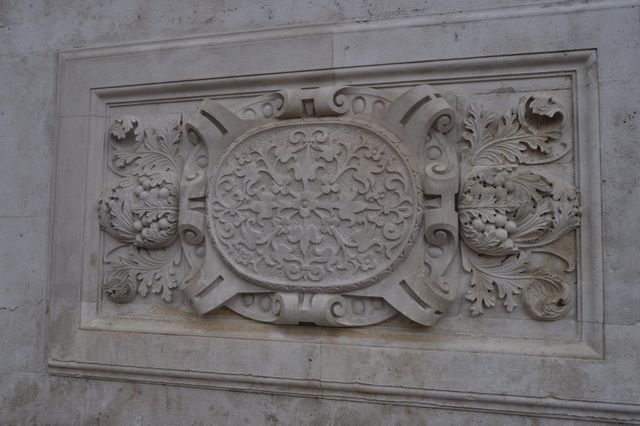
I'd assume we have a corrupt body behind this baroque
marble niche cover.
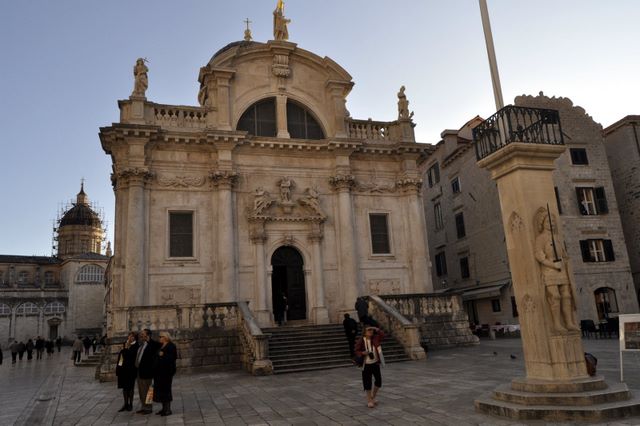
Here we see the cathedral dome at far left, St. Blaise
with its monumental stairway at center, and the Gothic
column of Roland at right.

Let's now climb southward up what was once the island's
steep slope to the Jesuit church.
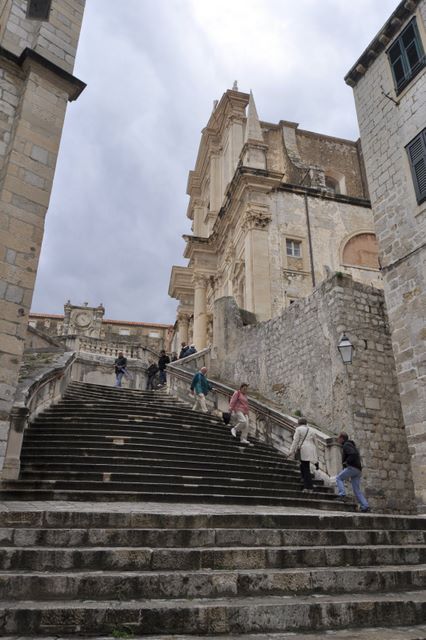
We ascend that slope using this monumental staircase
built in 1738 by Pietro Passalacqua. Passalacqua later
worked on several basilica facades in Rome. While these
steps could use a bit of spiffying up, they were
extensively repaired after being damaged in 1991 by Serb
shelling. Dubrovnik likes tourists to believe that these
resemble...
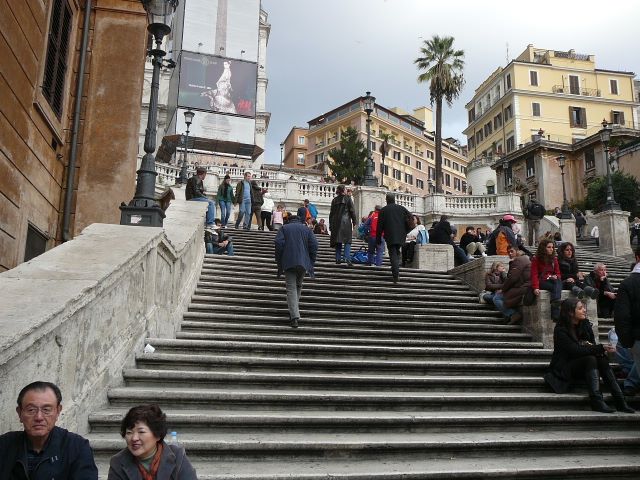
...the Spanish Steps in Rome built about a decade
earlier. But that's a huge stretch; while it's clear that
Pietro Passalacqua would be familiar with that similar
ascent, Dubrovnik's space is much more constricted...
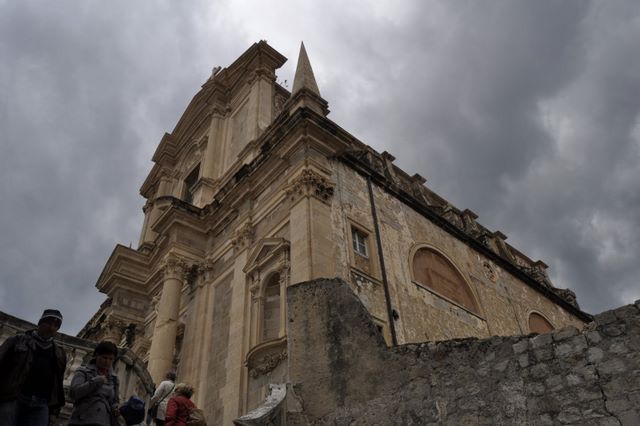
...and have none of the width and colonnaded terraces of
Rome's Spanish Steps. The approach here, however,
provides the requisite Baroque visual explosion of
awe.
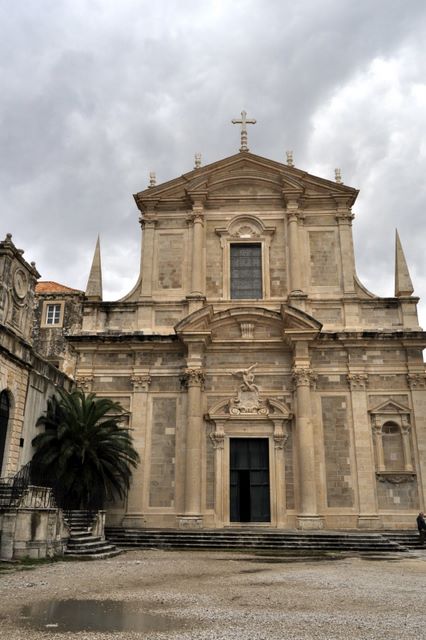
The facade is similar to another Roman structure -- the
one with which this Church of St. Ignatius shares its
name. In those days, many members of the order were
architects and deliberately shared plans to create a
Jesuit style. That's the case here with this church built
between 1699 and 1725.Look closely at the foreground.
Although this is one of town's major squares, it is not
paved and drainage of the October rains is somewhat
challenged. In Venice, this would be a square built over
a cistern that would hold the rainwater. With Onofrio's
aqueduct, this is unnecessary here.
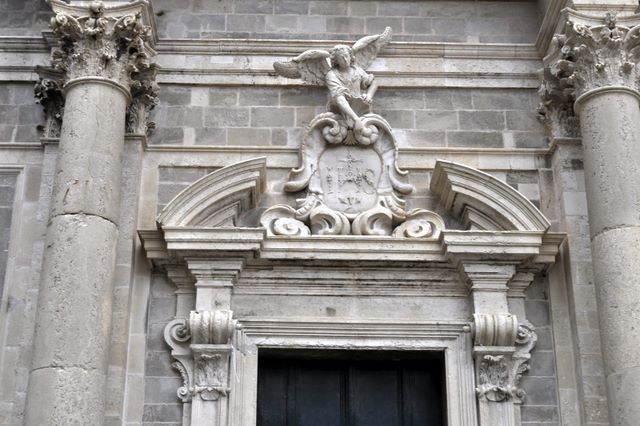
The portal shows an angel guarding the IHS seal of the
Jesuit order between the 2 large Corinthian columns that
accent the center of the facade.

This view shows a trace of the thin baroque facade at
center -- and the much simpler buttressesed nave and side
chapels. To the left is the old university, Collegium
Ragusinum.
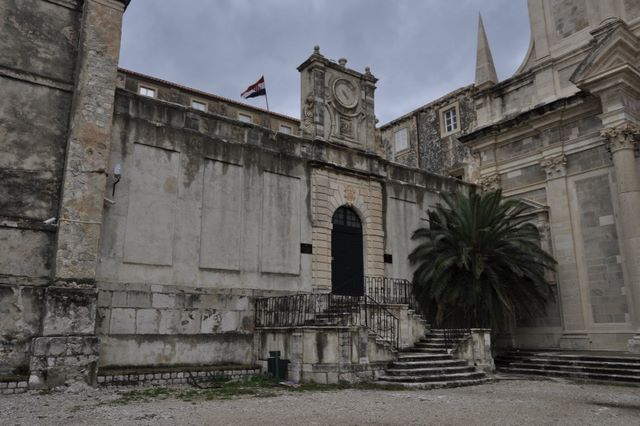
Built perpendicular to the church, the old Collegium
Ragusinum educated Dubrovnik's elite.
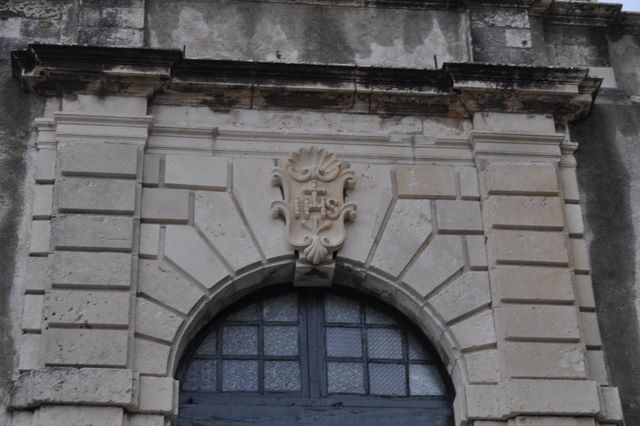
It too sports the Jesuit seal over its arched doorway.
It is now a high school and a seminary. Students here
take four years of Latin and classical Greek. (Is there
any other way?)
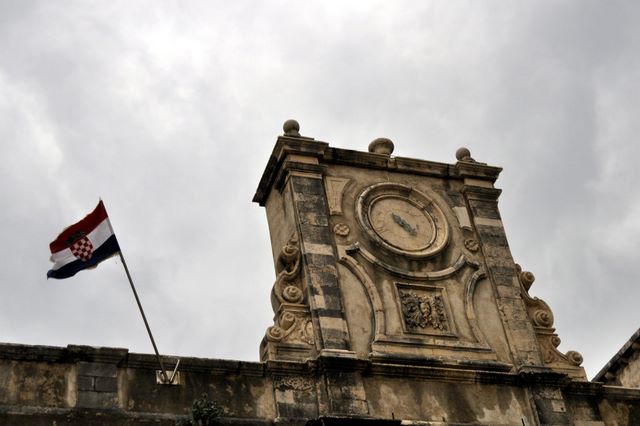
This clock rises above the Collegium Ragusinum building.
About 3 decades after the Jesuit order was disbanded in
1773, Napoleon's troops used the place as a hospital and
it had several other lives before Dubrovnik's bishop
established the seminary and high school in the building
in 1941.
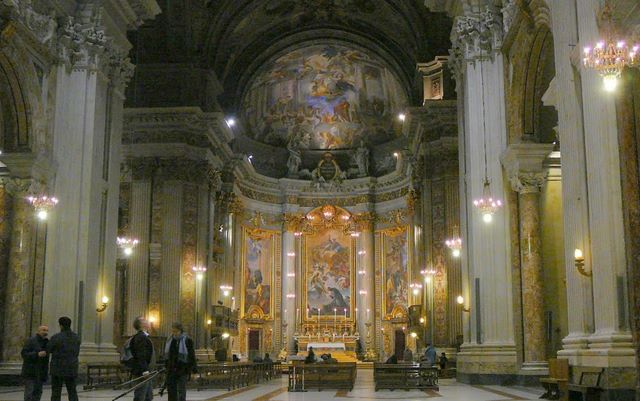
The church is the work of the Jesuit architect Andrea
Pozzo. Inside, Dubrovnik's St. Ignatius is clearly
inspired by its namesake in Rome, built over 6 decades
starting in 1626 and shown above from our last visit in
2007. Compare it to Dubrovnik's...

...and frescoed apse half-dome over the IHS symbol of
the Jesuits.
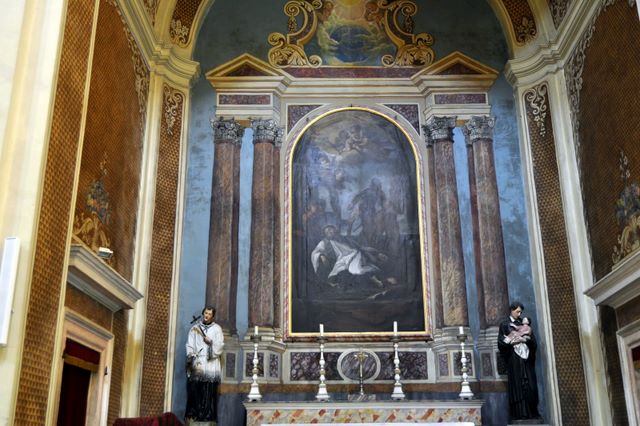
Here's a side altar in Dubrovnik...
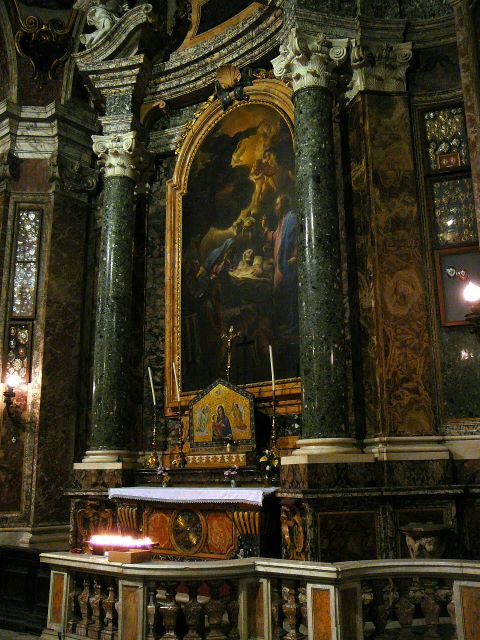
...and at St. Ignatius in Rome.
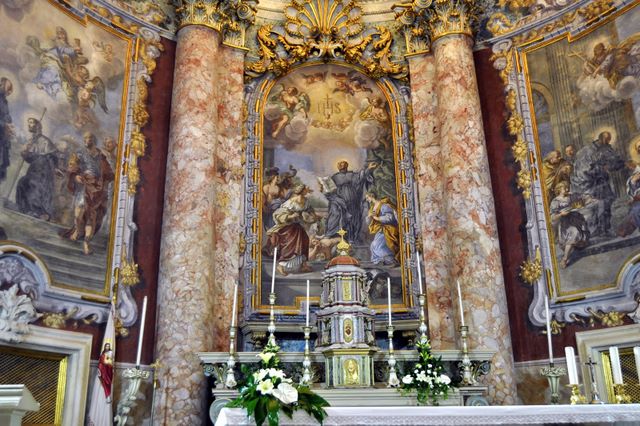
Around the main altar, we see a series of frescoes by
the Sicilian Gaetano Garcia showing scenes from the life
of the Jesuit founder, Ignatius of Loyola. Here this
former Basque warrior holds the Book of Rules of the
Society of Jesus. The four women represent the four
continents where the Jesuits had established missions and
universities.
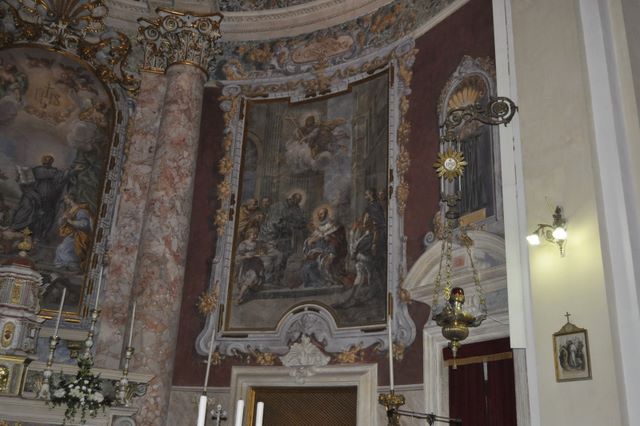
Garcia's fresco on the epistle side shows Ignatius
accepting Francisco Borgia (who became the third Superior
General of the order) into the Society...
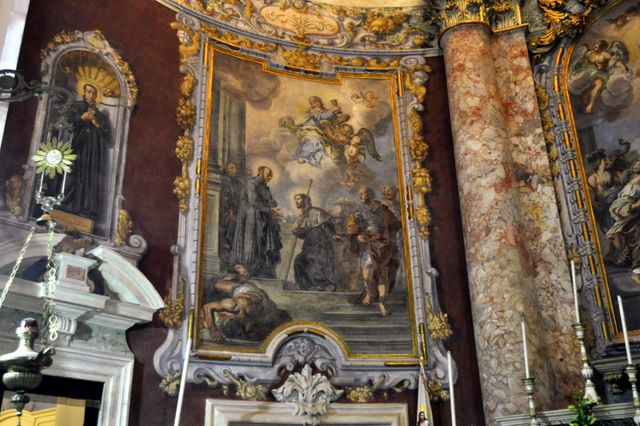
...and on the gospel side, Ignatius sends Francis Xavier
out to the missions.
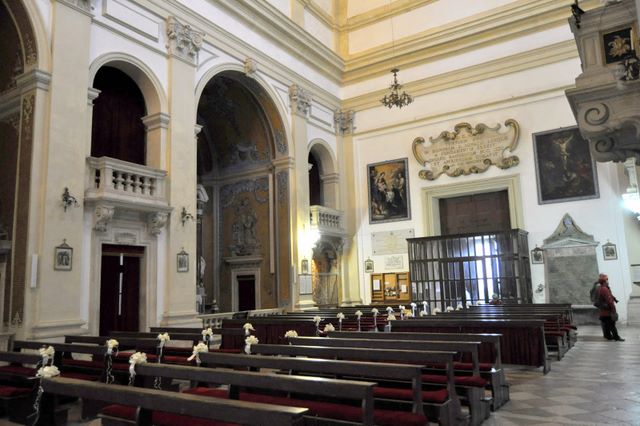
This view looks toward the rear of the church and shows
one of the niches for the four side altars. At center,
under the far balcony is a grotto.
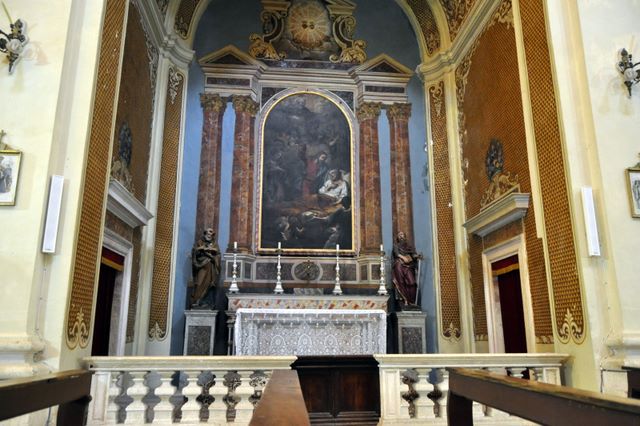
The painting here depicts the death of Francis Xavier on
the island of Santiano. By that time, Francis had
converted more people than anyone in history except for
Paul.
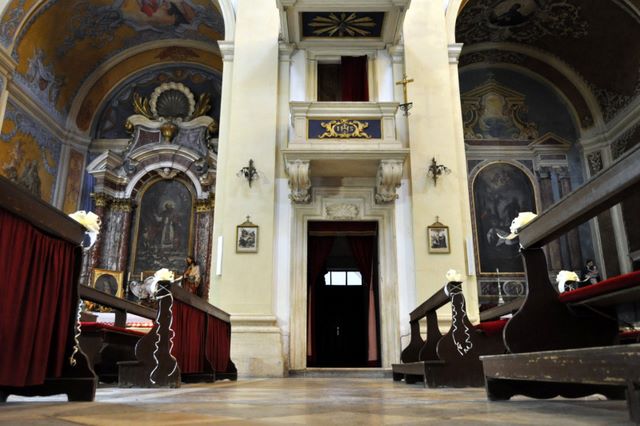
The pulpit seems rather subdued but fits harmoniously
between two side chapels.
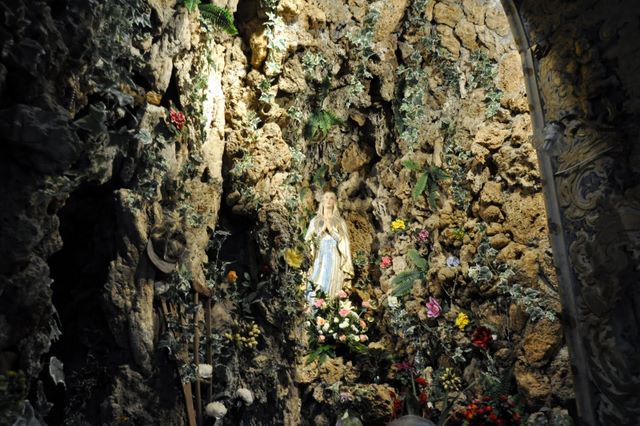
To the rear we find this incongruous non-baroque chapel
obviously imitating the grotto at Lourdes whose miracle
came about 125 years after this church was built. Somehow
we don't think that architect Pozzo would care much for
this. Built in 1885 and remodeled in 1966, it's one of
the oldest Lourdes chapels in the world.
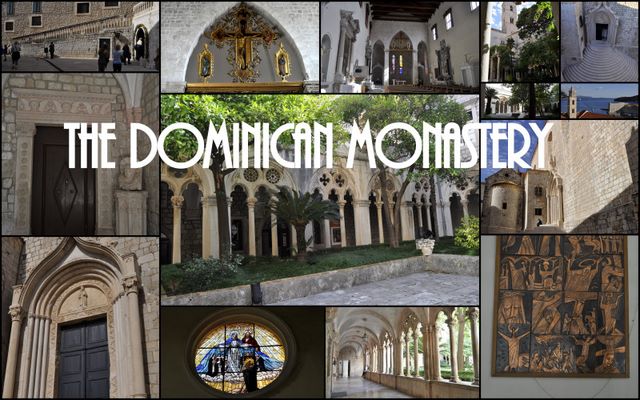
Like many medieval cities, Dubrovnik was civilized by
three major orders. Here the Franciscans held the west
end, the Jesuits the south, and the Dominican's started
east of the city.

Established in 1225, the Dominican monastery is readily
identifiable from its tower. Much of the present complex
was completed in the 14th century. Its position near the
harbor was at a key point in the town's defenses.
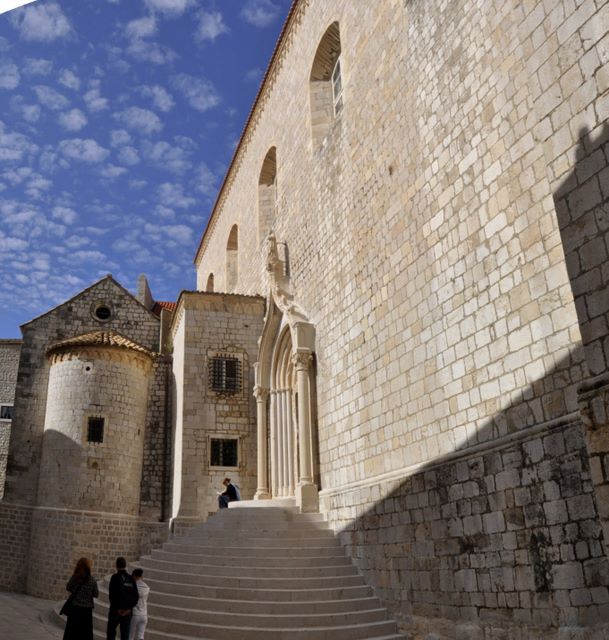
Consequently, parts of the church and monastery were
once part of the town's defensive walls, resulting in
some rather uninspiring architecture. Eventually the
walls were extended to envelope the monastery and we'd
assume that decorative doorways and these half-circular
stairs were added afterward.
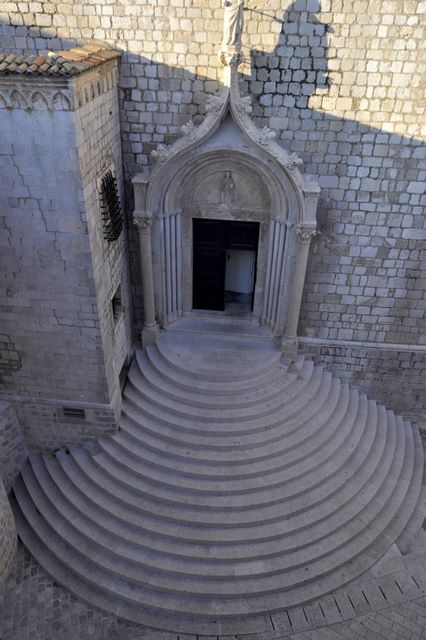
Bonino of Milan added this now beautifully restored
Gothic arch to the southern entrance to the church in
1419. The half-round stairs solve the problem of the
church being built on a hillside with its worship space
high above the street level. It unfolds elegantly beneath
the simple small ashlar wall.

A close-up of this door shows St. Dominic in the
lunette.

The other side of the complex solves the same problem
with a gently rising stairs behind a Gothic railing.
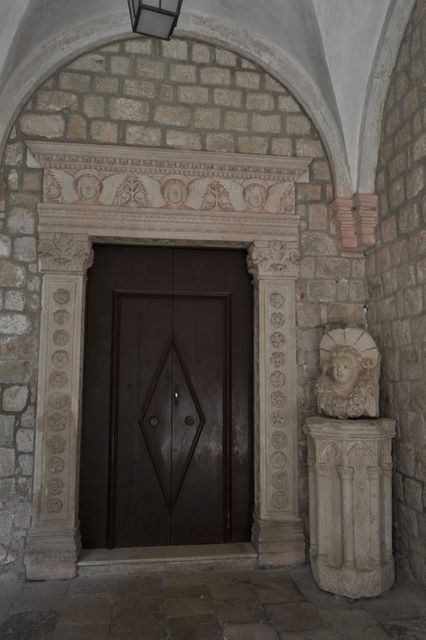
Inside the cloister, we find other elegant doorways.
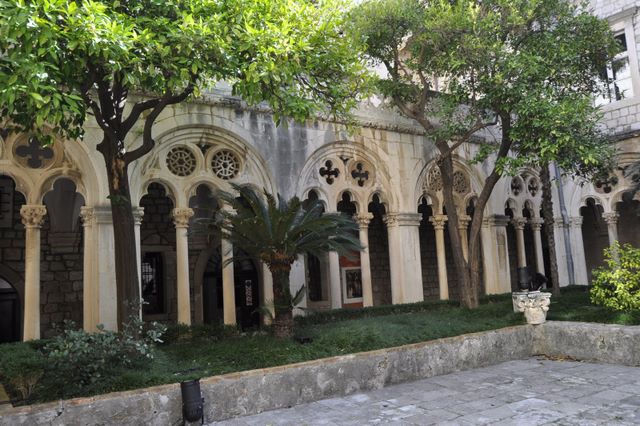
Since the cloister of the Franciscan monastery is near
the gate where the majority of tourists enter, its
cloister is often filled with tour guides shepherding
their charges. By contrast, the Dominican cloister at the
other end of the old town is nearly empty. The beauty of
these arches with their trifora openings is enhanced by
the quiet.
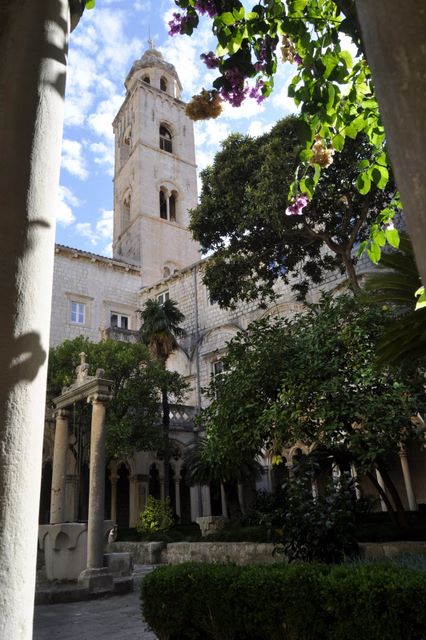
At left we see the cistern. In the rear rises the bell
tower which Checo of Monopoli began in the 16th century;
it was not completed until the 18th century.

This is quite an elegant arch to hold up the pulley. As
we'd expect in a complex built over many centuries, a
variety of architectural styles were employed. However,
the place is more late Gothic and early Renaissance than
anything else.
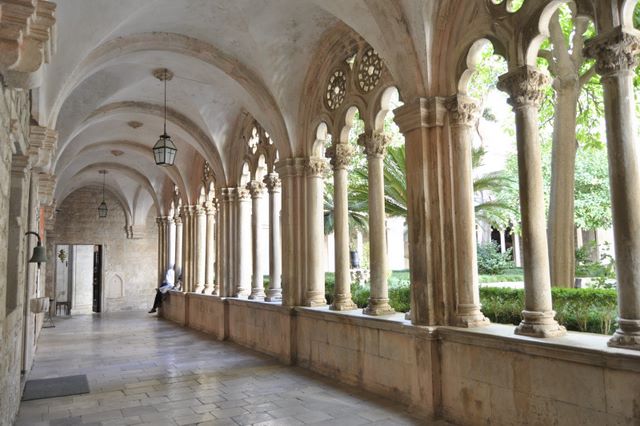
Massa di Bartolomeo from Florence did the overall design
of the cloister porches in the 15th century. Local
builders did the actual work between 1456 and 1483.
Unlike the Gothic capitals at the Franciscan monastery at
the west end of Dubrovnik, these are fairly uniform --
and renaissance.

Inside, we have a great hall church -- a large worship
space designed to bring in huge numbers of the faithful
to hear the sermon. In fact, this is one of the largest
Gothic buildings on the eastern Adriatic coast. The box
of the nave leads to a 3-arched sanctuary that suggests a
Gothic cathedral with its nave and side aisles.
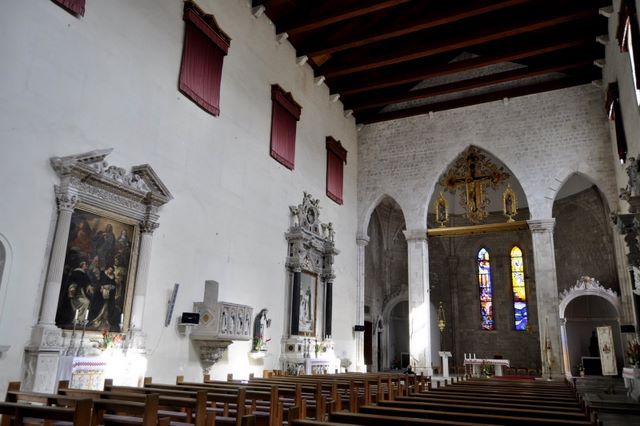
Note that the side altars are appendages on the simple
wall rather than being deep niches or separate chapels.
Note the crucifix separating the sanctuary from the
seating area. When built, the center of the action here
was at the center of the left wall ...
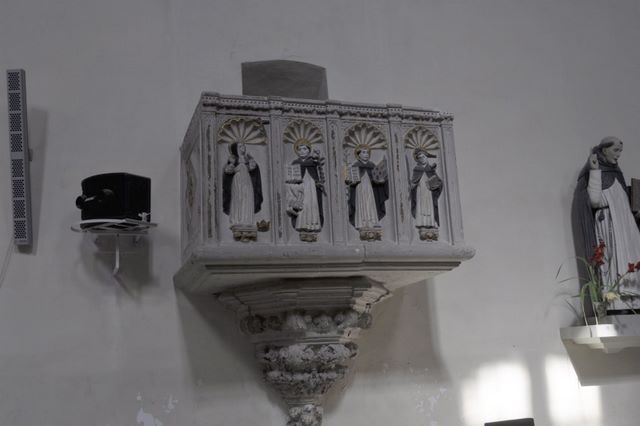
... the pulpit sporting Mary and several Dominican
saints. It's now inaccessible and replaced by the Bose
speaker at left.
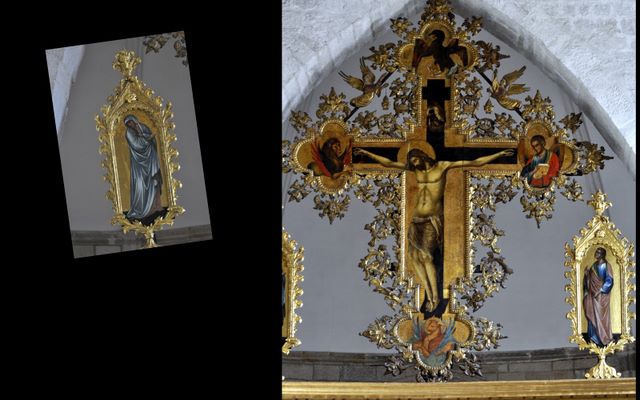
Here's a close-up of the crucifix and the icons that
separate the pentagonal apse from the nave. The monastery
is now a museum with an outstanding collection of the
Dubrovnik school which flourished in the 15th and 16th
centuries. Like the Franciscan monastery, it also has a
large collection on early printed books called incunables
as well as many illustrated manuscripts.
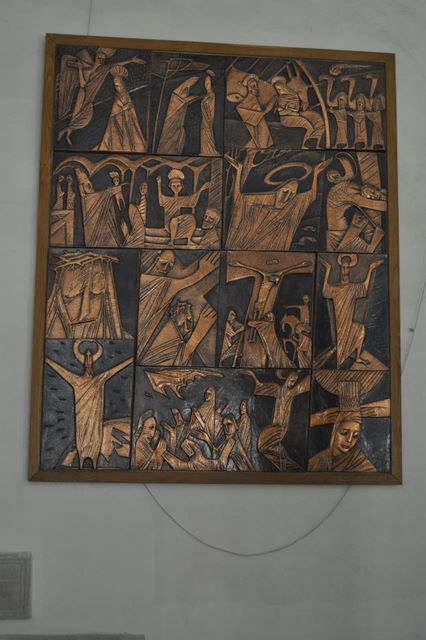
But not all of the art is from the Renaissance: here we
have a modern rendering of screens from the life of Mary
starting with the Annunciation at upper left through the
Coronation at lower right...
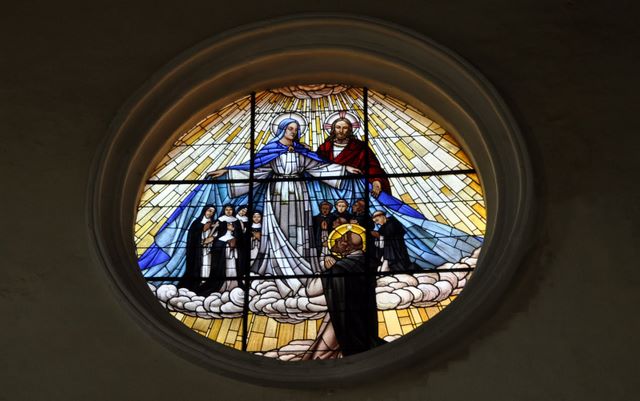
...the windows seem caught somewhere between the high
Renaissance and the modern.

Besides the large monasteries and churches such as St.
Ignatius and St. Blaise, the town is features many
smaller churches -- or what must have been chapels. Here
a religious lintel now greets gallery shoppers.

The northern end has a high street that parallels the
Placa. It's called Prijeko Street and it ends at the tiny
church of St. Nicholas.
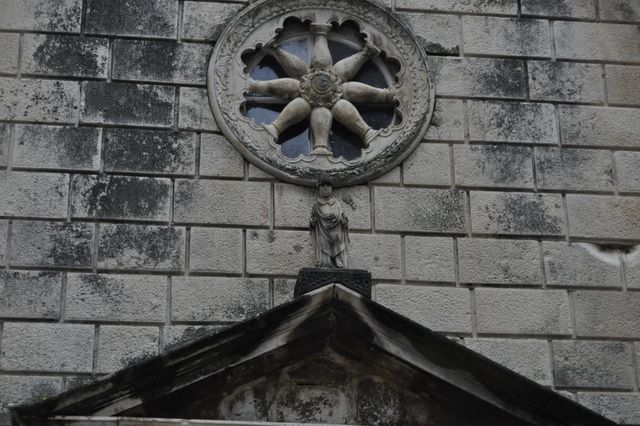
Built in the 11th century, it's one of the oldest in
Dubrovnik but this facade is from the 16th century.
Nearby is the 1408 baroque Jewish Synagogue, the oldest
Sephardic synagogue still in use today (unfortunately, no
pictures were allowed inside). When Ferdinand and Isabel
expelled the Jews in 1492, most went to the Ottoman
Empire but some came here.
![]()
While mostly Roman Catholic, Dubrovnik has its Orthodox
worship space as well, situated along one of its rows of
T-shirt shops.
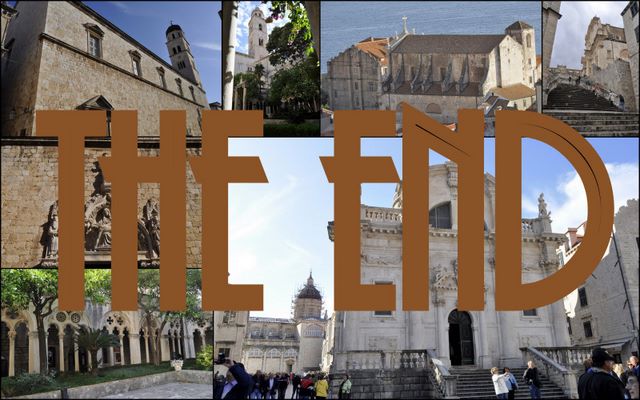
Thanks for visiting. See our overall Dubrovnik
presentation by clicking here -- or visit
all of our travel pages by clicking here.
|
Please join us in the following slide show to give Dubrovnik Churches and Monasteries the viewing they deserve by clicking here. |
Geek and Legal StuffPlease allow JavaScript to enable word definitions. This page has been tested in Internet Explorer 8.0, Firefox 3.0, and Google Chrome 1.0. Created on January 10, 2010 |
 |